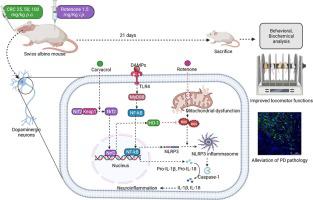当前位置:
X-MOL 学术
›
Brain Res.
›
论文详情
Our official English website, www.x-mol.net, welcomes your feedback! (Note: you will need to create a separate account there.)
Neuroprotective role of Carvacrol via Nrf2/HO-1/NLRP3 axis in Rotenone-induced PD mice model
Brain Research ( IF 2.7 ) Pub Date : 2024-04-20 , DOI: 10.1016/j.brainres.2024.148954 Shruti Shah , Kamatham Pushpa Tryphena , Gurpreet Singh , Amrita Kulkarni , Poojitha Pinjala , Dharmendra Kumar Khatri
Brain Research ( IF 2.7 ) Pub Date : 2024-04-20 , DOI: 10.1016/j.brainres.2024.148954 Shruti Shah , Kamatham Pushpa Tryphena , Gurpreet Singh , Amrita Kulkarni , Poojitha Pinjala , Dharmendra Kumar Khatri

|
Parkinson’s disease (PD) is a multifactorial neurodegenerative disorder whose cause is unclear. Neuroinflammation is recognized as one of the major pathogenic mechanisms involved in the development and progression of PD. NLRP3 inflammasome is the most widely studied inflammatory mediator in various diseases including PD. Several phytoconstituents have shown neuroprotective role in PD. Carvacrol is a phenolic monoterpene commonly found in the essential oils derived from plants belonging to Lamiaceae family. It is well known for its anti-inflammatory and antioxidant properties and has been widely explored in several diseases. In this study, we explored the role of Carvacrol in suppressing neuroinflammation by regulating NLRP3 inflammasome through Nrf2/HO-1 axis and subsequently, inflammatory cytokines like IL-1β, IL-18 in Rotenone induced PD mice model. Three doses (25 mg/kg, 50 mg/kg, 100 mg/kg ) of Carvacrol were administered to, respectively, three groups (LD, MD, HD), one hour after administration of Rotenone (1.5 mg/kg, ), every day, for 21 days. Treatment with Carvacrol ameliorated the motor impairment caused by Rotenone. It alleviated neurotoxicity and reduced inflammatory cytokines. Further, Carvacrol also alleviated oxidative stress and increased antioxidant enzymes. From these results, we show that Carvacrol exerts neuroprotective effects in PD via anti-inflammatory and antioxidant mechanisms and could be a potential therapeutic option in PD.
中文翻译:

香芹酚通过 Nrf2/HO-1/NLRP3 轴在鱼藤酮诱导的 PD 小鼠模型中的神经保护作用
帕金森病(PD)是一种多因素神经退行性疾病,其病因尚不清楚。神经炎症被认为是PD发生和进展的主要致病机制之一。 NLRP3 炎症小体是包括 PD 在内的多种疾病中研究最广泛的炎症介质。几种植物成分在帕金森病中显示出神经保护作用。香芹酚是一种酚类单萜,常见于唇形科植物精油中。它以其抗炎和抗氧化特性而闻名,并已在多种疾病中得到广泛探索。在本研究中,我们通过 Nrf2/HO-1 轴调节 NLRP3 炎症小体,进而在鱼藤酮诱导的 PD 小鼠模型中调节 IL-1β、IL-18 等炎症细胞因子,探讨了香芹酚在抑制神经炎症中的作用。在施用鱼藤酮(1.5 mg/kg,)后一小时,分别向三组(LD、MD、HD)施用三剂香芹酚(25 mg/kg、50 mg/kg、100 mg/kg),每天,持续 21 天。香芹酚治疗改善了鱼藤酮引起的运动障碍。它减轻了神经毒性并减少了炎症细胞因子。此外,香芹酚还可以减轻氧化应激并增加抗氧化酶。从这些结果中,我们表明香芹酚通过抗炎和抗氧化机制对帕金森病发挥神经保护作用,并可能成为帕金森病的潜在治疗选择。
更新日期:2024-04-20
中文翻译:

香芹酚通过 Nrf2/HO-1/NLRP3 轴在鱼藤酮诱导的 PD 小鼠模型中的神经保护作用
帕金森病(PD)是一种多因素神经退行性疾病,其病因尚不清楚。神经炎症被认为是PD发生和进展的主要致病机制之一。 NLRP3 炎症小体是包括 PD 在内的多种疾病中研究最广泛的炎症介质。几种植物成分在帕金森病中显示出神经保护作用。香芹酚是一种酚类单萜,常见于唇形科植物精油中。它以其抗炎和抗氧化特性而闻名,并已在多种疾病中得到广泛探索。在本研究中,我们通过 Nrf2/HO-1 轴调节 NLRP3 炎症小体,进而在鱼藤酮诱导的 PD 小鼠模型中调节 IL-1β、IL-18 等炎症细胞因子,探讨了香芹酚在抑制神经炎症中的作用。在施用鱼藤酮(1.5 mg/kg,)后一小时,分别向三组(LD、MD、HD)施用三剂香芹酚(25 mg/kg、50 mg/kg、100 mg/kg),每天,持续 21 天。香芹酚治疗改善了鱼藤酮引起的运动障碍。它减轻了神经毒性并减少了炎症细胞因子。此外,香芹酚还可以减轻氧化应激并增加抗氧化酶。从这些结果中,我们表明香芹酚通过抗炎和抗氧化机制对帕金森病发挥神经保护作用,并可能成为帕金森病的潜在治疗选择。








































 京公网安备 11010802027423号
京公网安备 11010802027423号